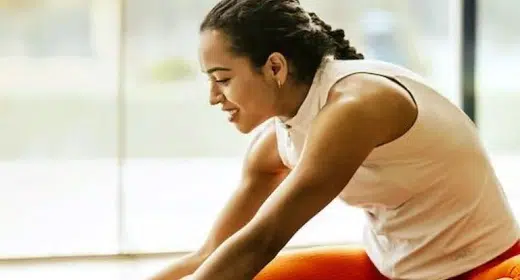by Julie Peters: Hurting? Yoga for arthritis can soothe your joints and diminish pain…
There are over 100 different types of arthritis, but all involve some version of joint pain, stiffness, and/or swelling, and almost all can benefit from a yoga for arthritis practice.
You may think a yoga practice involves tying your body up like a pretzel—that’s not the case. In fact, perhaps the best thing about yoga is that it’s always about what you can do, not about what you can’t. If, for example, you can’t put weight on your wrists or twist your spine or bend backward, there is always a modification or an option to try in a yoga practice. Whatever condition your joints are in, yoga can help.
Creating Alignment
One of the simplest ways to diminish joint pain is to align the joints properly. Yoga helps to improve mobility and strength in the whole body while taking into account the way the bones and joints move together. Focusing on gently aligning the bones and strengthening and stretching the muscles around them can help to ease the inflammation and pain associated with many forms of arthritis. In the case of something like ankylosing spondylitis, in which the joints may fuse together, yoga can help maintain an easeful posture even when and if the joints no longer move.
Diminishing Stress
Arthritis causes pain because there is a problem that the body is signaling to the brain. That’s reasonable, but arthritis is also a long-term condition, and so over time those pain signals become less useful.
Yoga is known for its stress-relieving qualities, and stress is notorious for exacerbating pain signals in the nervous system. When we are stressed, the body is likelier to flare with pain signals. If we can stay calm and breathe deeply, those pain signals can be eased. Yoga not only helps with proper alignment and posture, it can also help dampen the nervous system’s interpretation of pain
Using Props and Modifications
Yoga postures are meant to fit your body, not the other way around. Rather than trying to bend over backwards—literally—to fit some ideal of the pose, instead use modifications to address the intention—rather than the image—of the pose.
Yoga postures are essentially just a bunch of variations on backbends, forward bends, twists, side bends, balancing postures, hip openers, core strengtheners, and inversions. If Pigeon Pose hurts your knee, for example, try a different hip opener, like Thread the Needle. If Plank Pose, a core strengthening pose, is too hard on your wrists, try it against a wall—or even just do some crunches instead.
Props are another key strategy to make a yoga practice work for you. Blocks, cushions, straps, and bolsters are often used to help bring the floor up to meet your body, such as when you place your hands on blocks in a forward bend instead of trying to touch the floor. Some props can make limbs longer, such as using a strap to hold your hands around behind your back to open the shoulders rather than trying to make the hands link together. For some people, props are the magic key that opens up a yoga for arthritis practice.
Breathing Better
It’s rare to find a yoga class that doesn’t focus on the breath in some way. Most yoga practices involve linking movement with a slow, deep breath, and this can have a profound effect on stress in the body. Some forms of arthritis, such as ankylosing spondylitis, can affect one’s ability to breathe. Exploring different forms of breath in a yoga practice can help to find a way to breathe more deeply. For example, if the rib, chest, and shoulder joints are tight, yoga can help teach you to breathe into your belly.
Breathing more deeply and intentionally is a powerful way to calm stress in the body, further addressing the link between stress and pain. When we are able to calm stress, we also tend to improve digestion, immune function, sleep, and mood.
Contraindications
Not all yoga practices and postures are safe and effective for arthritis. It depends on where you feel your joint pain, but the major places to look out for are neck, wrists, and knees. Some yoga postures require the knees to bend further than 90 degrees, such as the full Squat pose. Some classes also rely heavily on Downward Dogs and Plank Pose, which are pretty intensive on the wrists. Hands and forearms can strengthen to support the wrists, but it might be worth exploring seated modifications or putting your weight on the forearms instead.
The major rule is: If it hurts—stop!
Types of Yoga for Arthritis
Studies have shown that Iyengar yoga, which is a slow and mindful style focused primarily on alignment, is an excellent choice for arthritis. Styles like Power Yoga and Kundalini can sometimes be faster paced or involve holding postures for a little too long for an inflamed joint.
Everyone is different, so you may need to experiment a little bit around which styles of yoga you enjoy and work best for your body. For some people with arthritis, moving in and out of postures gently with a flowing intention is best. For others, holding postures for longer is the best choice.
A lot of the time, however, it comes down to whether or not you like the teacher! Be sure to find someone who knows how to modify a practice and give you ideas for how best to care for your body in the practice. You might even find a dedicated yoga for arthritis class in your area or online. If you don’t like the first class you take, don’t give up: There are almost infinite styles and teachers to choose from, so there will eventually be one you like.









































